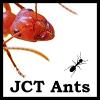Hello all, I just got done checking on my Camponotus pennsylvanicus queen with her larvae today. She is in hibernation with her larvae in the garage . I will for sure feed her when i take her out, but she seems a little too skinny to finish the rest of her hibernation? Will she make it by the looks of her? Should I take her out sooner than normal. She has been in for a little over a month.






















